child restraint JEEP COMMANDER 2008 1.G Owners Manual
[x] Cancel search | Manufacturer: JEEP, Model Year: 2008, Model line: COMMANDER, Model: JEEP COMMANDER 2008 1.GPages: 478, PDF Size: 6.97 MB
Page 12 of 478

NProgramming Additional Transmitters........25
NTransmitter Battery Service...............25
NGeneral Information....................26
mRemote Starting System Ð If Equipped........26
mDoor Locks............................28
NManual Door Locks.....................28
NPower Door Locks.....................29
NChild Protection Door Lock...............30
mWindows.............................31
NPower Windows.......................31
NWind Buffeting........................33
mLiftgate...............................34
NLiftgate Flipper Glass...................35NPower Liftgate Ð If Equipped.............36
mOccupant Restraints......................38
NLap/Shoulder Belts.....................39
NLap/Shoulder Belt Operating Instructions.....40
NAdjustable Upper Shoulder Belt Anchorage....44
NAutomatic Locking Mode Ð If Equipped.....44
NEnergy Management Feature..............45
NSeat Belt Pretensioners...................46
NEnhanced Seat Belt Use Reminder System
(BeltAlert)...........................46
NSeat Belts And Pregnant Women............47
NSeat Belt Extender......................48
NDriver And Front Passenger Supplemental
Restraint Systems (SRS)..................48
12 THINGS TO KNOW BEFORE STARTING YOUR VEHICLE
Page 13 of 478
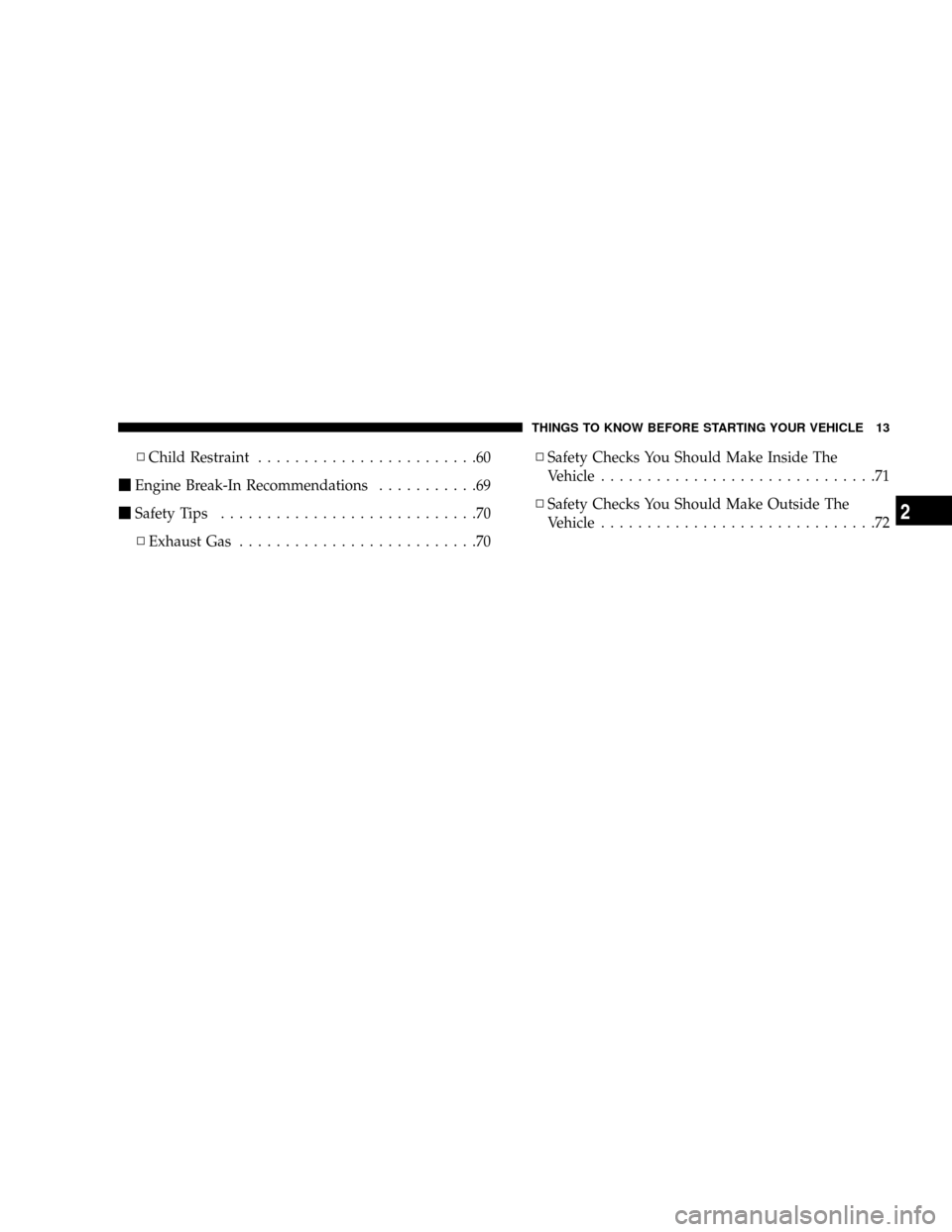
NChild Restraint........................60
mEngine Break-In Recommendations...........69
mSafety Tips............................70
NExhaust Gas..........................70NSafety Checks You Should Make Inside The
Vehicle..............................71
NSafety Checks You Should Make Outside The
Vehicle..............................72
THINGS TO KNOW BEFORE STARTING YOUR VEHICLE 13
2
Page 38 of 478
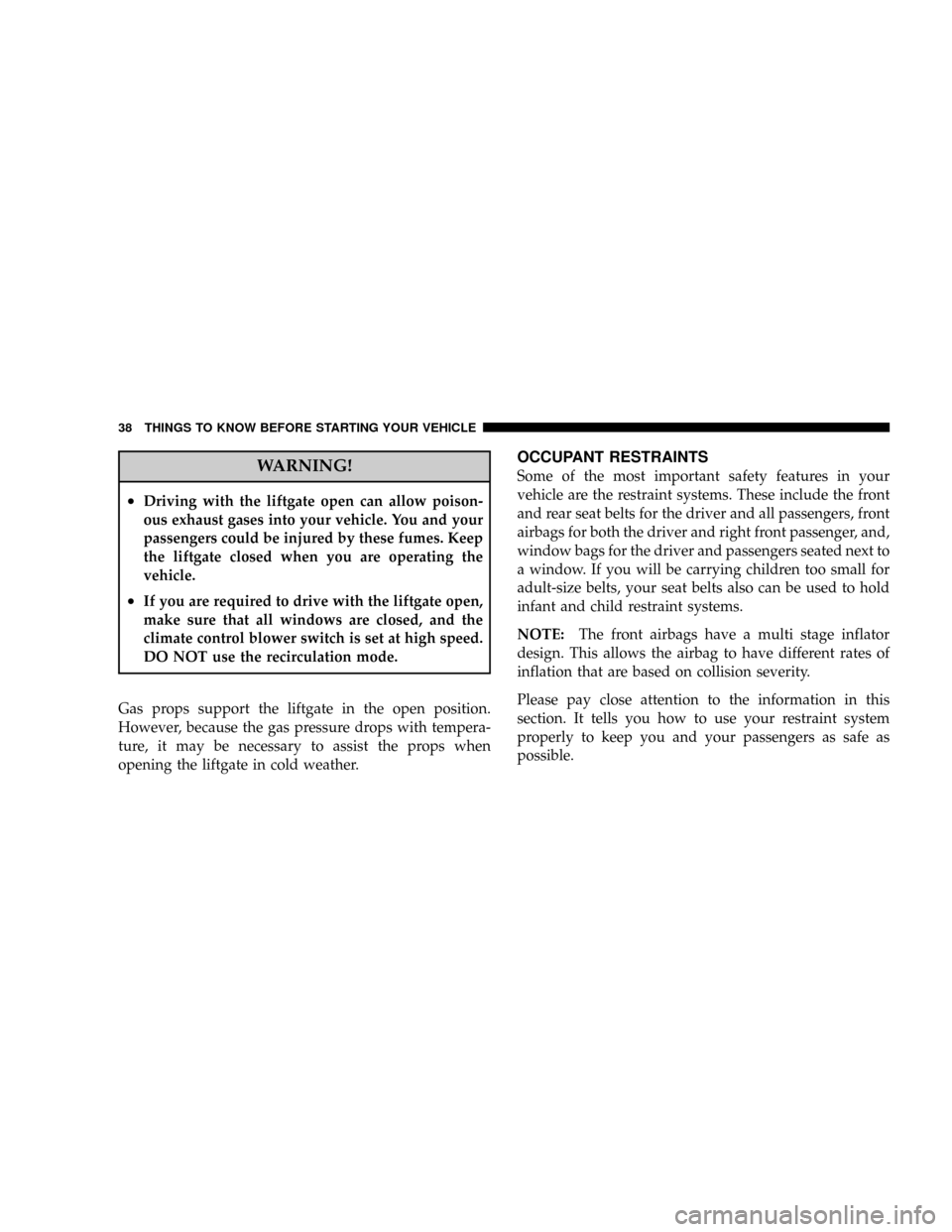
WARNING!
²Driving with the liftgate open can allow poison-
ous exhaust gases into your vehicle. You and your
passengers could be injured by these fumes. Keep
the liftgate closed when you are operating the
vehicle.
²If you are required to drive with the liftgate open,
make sure that all windows are closed, and the
climate control blower switch is set at high speed.
DO NOT use the recirculation mode.
Gas props support the liftgate in the open position.
However, because the gas pressure drops with tempera-
ture, it may be necessary to assist the props when
opening the liftgate in cold weather.
OCCUPANT RESTRAINTS
Some of the most important safety features in your
vehicle are the restraint systems. These include the front
and rear seat belts for the driver and all passengers, front
airbags for both the driver and right front passenger, and,
window bags for the driver and passengers seated next to
a window. If you will be carrying children too small for
adult-size belts, your seat belts also can be used to hold
infant and child restraint systems.
NOTE:The front airbags have a multi stage inflator
design. This allows the airbag to have different rates of
inflation that are based on collision severity.
Please pay close attention to the information in this
section. It tells you how to use your restraint system
properly to keep you and your passengers as safe as
possible.
38 THINGS TO KNOW BEFORE STARTING YOUR VEHICLE
Page 46 of 478

Seat Belt Pretensioners
The driver and front passenger seat belts are equipped
with a pretensioning device that is designed to remove
any slack from the seat belt systems in the event of a
collision. This device improves the performance of the
seat belt by assuring that the belt is tight around the
occupant early in a collision. Pretensioners work for all
size occupants, including those in child restraints.
NOTE:These devices are not a substitute for proper seat
belt placement by the occupant. The seat belt must still be
worn snugly and positioned properly.
The pretensioners are triggered by the Occupant Re-
straint Control (ORC) Module. Like the front airbags, the
pretensioners are a single use item. After a collision that
is severe enough to deploy the airbags and pretensioners,
they must be replaced.
Enhanced Seat Belt Use Reminder System
(BeltAlert)
If the driver's seat belt has not been buckled within 60
seconds of starting the vehicle and if the vehicle speed is
greater than 5 mph (8 km/h), the Enhanced Warning
System (BeltAlert) will alert the driver to buckle their seat
belt. The driver should also instruct all other occupants to
buckle their seat belts. Once the warning is triggered, the
Enhanced Warning System (BeltAlert) will continue to
chime and flash the Seat Belt Warning Light for 96
seconds or until the driver's seat belt is buckled. The
Enhanced Warning System (BeltAlert) will be reactivated
if the driver's seat belt is unbuckled for more than 10
seconds and the vehicle speed is greater than 5 mph (8
km/h).
The Enhanced Warning System (BeltAlert) can be en-
abled or disabled by your authorized dealer or by
following these steps:
46 THINGS TO KNOW BEFORE STARTING YOUR VEHICLE
Page 51 of 478
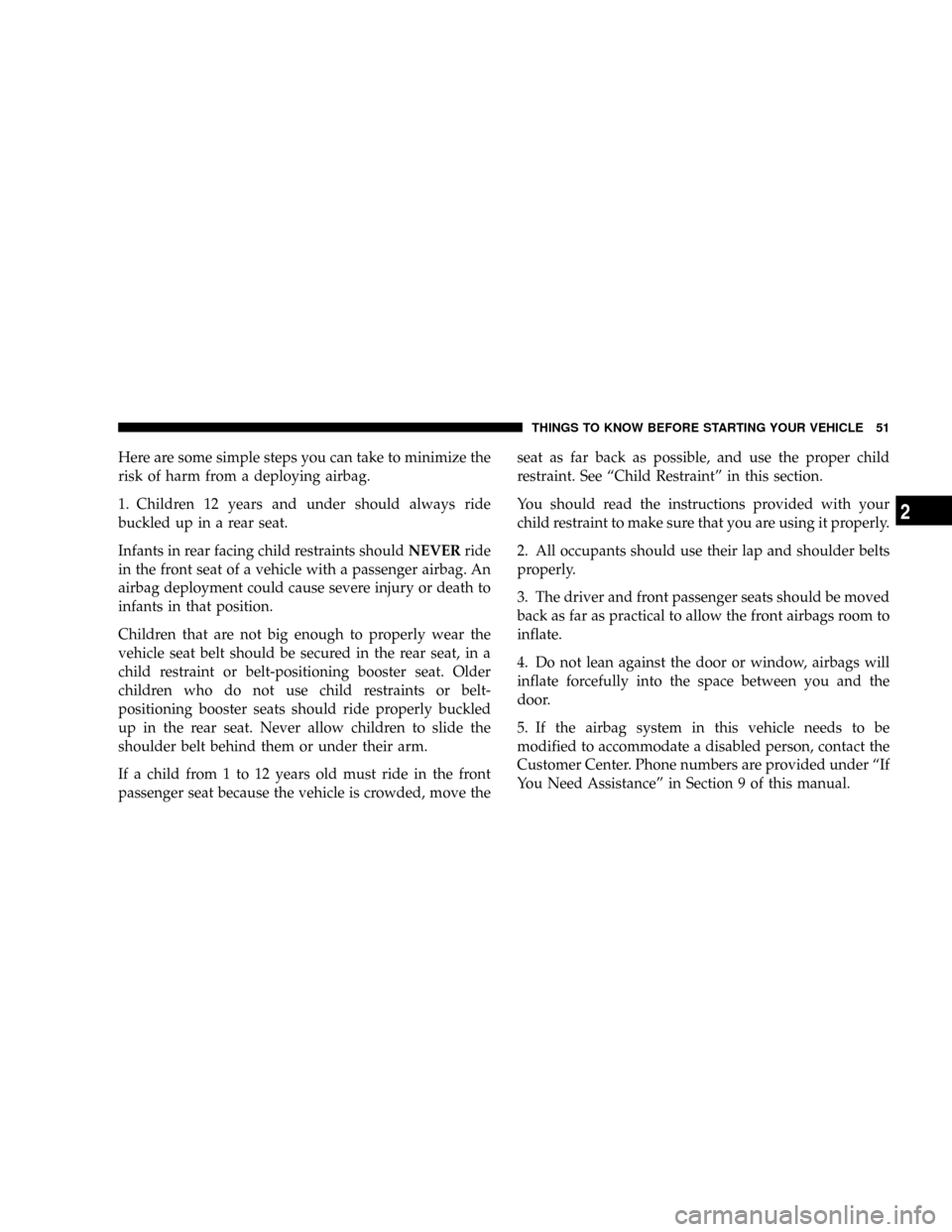
Here are some simple steps you can take to minimize the
risk of harm from a deploying airbag.
1. Children 12 years and under should always ride
buckled up in a rear seat.
Infants in rear facing child restraints shouldNEVERride
in the front seat of a vehicle with a passenger airbag. An
airbag deployment could cause severe injury or death to
infants in that position.
Children that are not big enough to properly wear the
vehicle seat belt should be secured in the rear seat, in a
child restraint or belt-positioning booster seat. Older
children who do not use child restraints or belt-
positioning booster seats should ride properly buckled
up in the rear seat. Never allow children to slide the
shoulder belt behind them or under their arm.
If a child from 1 to 12 years old must ride in the front
passenger seat because the vehicle is crowded, move theseat as far back as possible, and use the proper child
restraint. See ªChild Restraintº in this section.
You should read the instructions provided with your
child restraint to make sure that you are using it properly.
2. All occupants should use their lap and shoulder belts
properly.
3. The driver and front passenger seats should be moved
back as far as practical to allow the front airbags room to
inflate.
4. Do not lean against the door or window, airbags will
inflate forcefully into the space between you and the
door.
5. If the airbag system in this vehicle needs to be
modified to accommodate a disabled person, contact the
Customer Center. Phone numbers are provided under ªIf
You Need Assistanceº in Section 9 of this manual.
THINGS TO KNOW BEFORE STARTING YOUR VEHICLE 51
2
Page 60 of 478
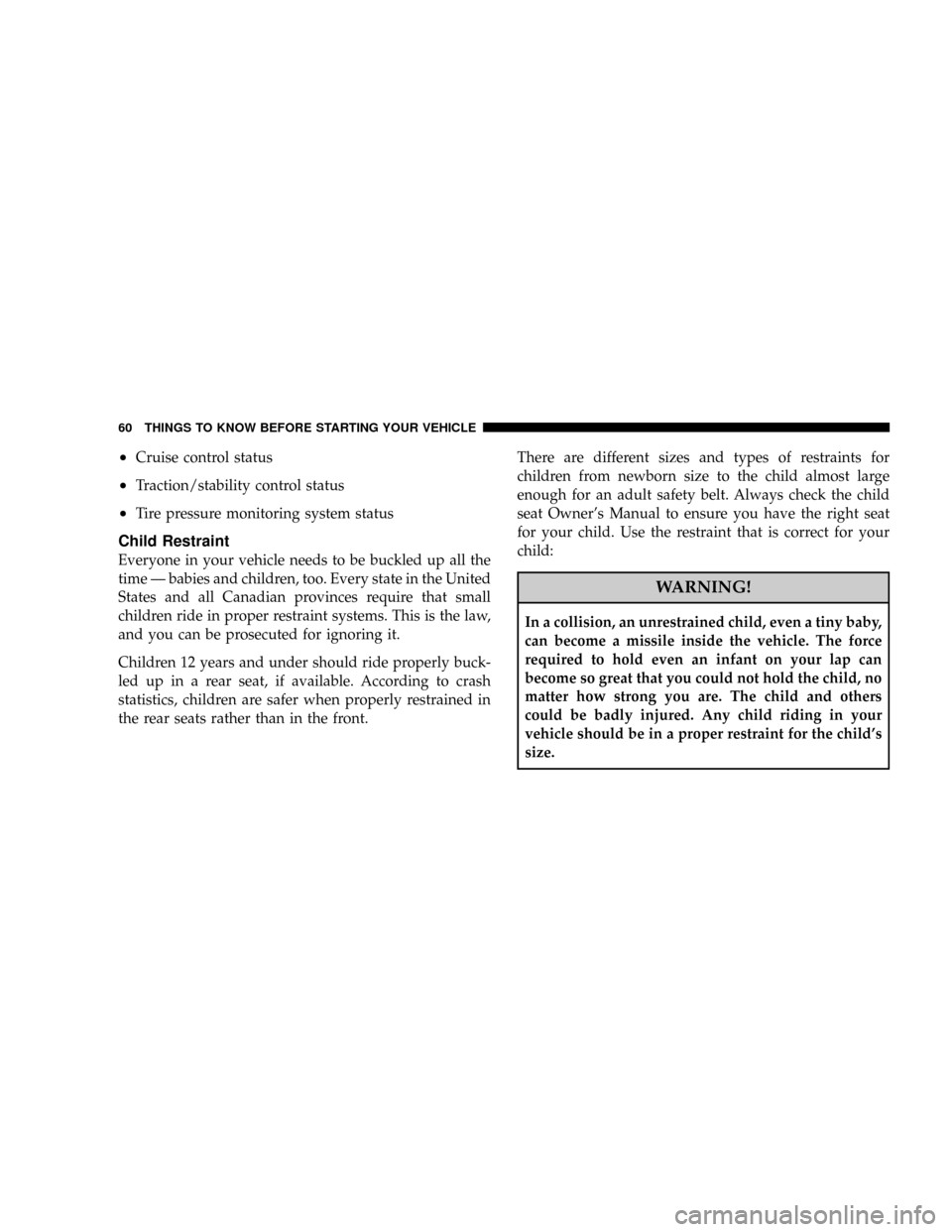
²Cruise control status
²Traction/stability control status
²Tire pressure monitoring system status
Child Restraint
Everyone in your vehicle needs to be buckled up all the
time Ð babies and children, too. Every state in the United
States and all Canadian provinces require that small
children ride in proper restraint systems. This is the law,
and you can be prosecuted for ignoring it.
Children 12 years and under should ride properly buck-
led up in a rear seat, if available. According to crash
statistics, children are safer when properly restrained in
the rear seats rather than in the front.There are different sizes and types of restraints for
children from newborn size to the child almost large
enough for an adult safety belt. Always check the child
seat Owner's Manual to ensure you have the right seat
for your child. Use the restraint that is correct for your
child:
WARNING!
In a collision, an unrestrained child, even a tiny baby,
can become a missile inside the vehicle. The force
required to hold even an infant on your lap can
become so great that you could not hold the child, no
matter how strong you are. The child and others
could be badly injured. Any child riding in your
vehicle should be in a proper restraint for the child's
size.
60 THINGS TO KNOW BEFORE STARTING YOUR VEHICLE
Page 61 of 478
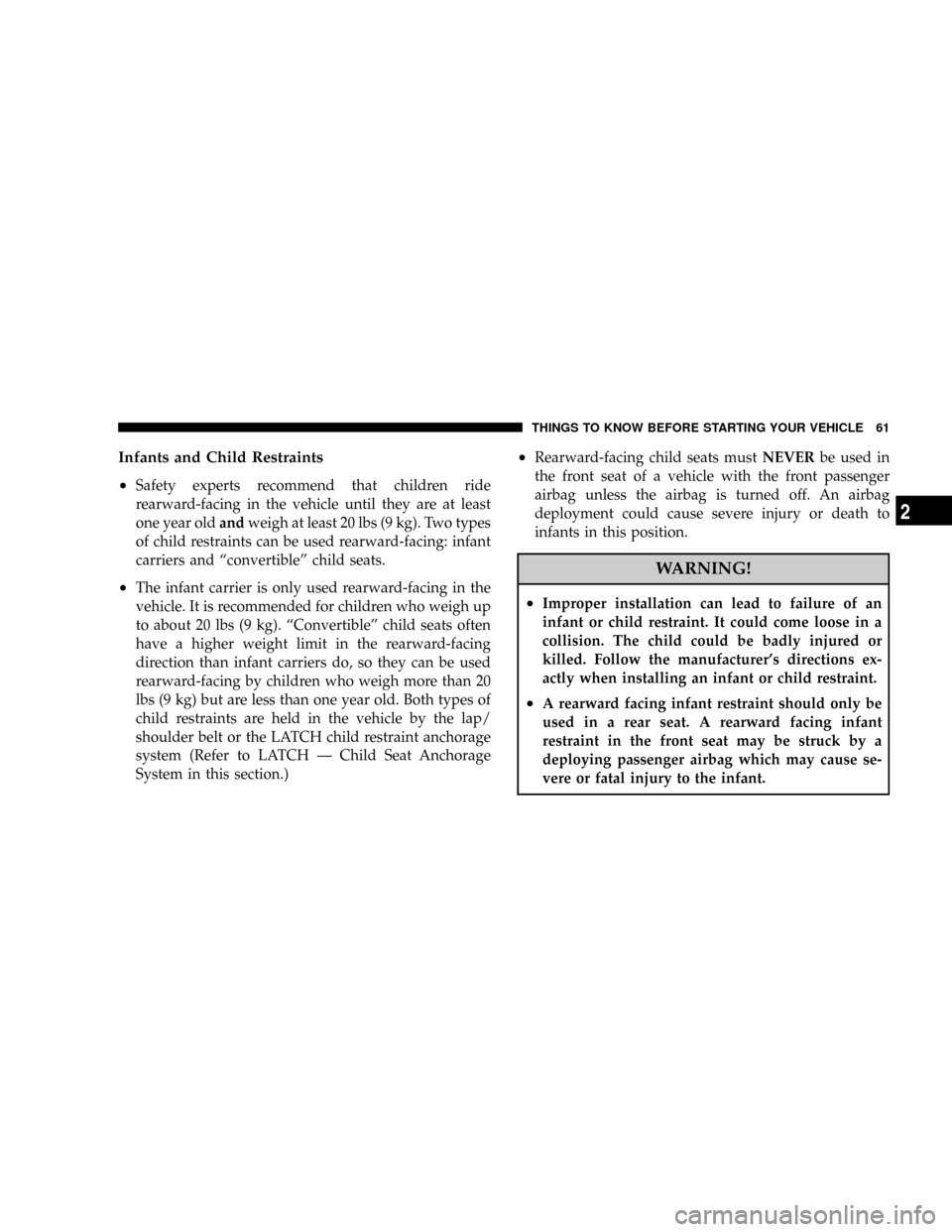
Infants and Child Restraints
²
Safety experts recommend that children ride
rearward-facing in the vehicle until they are at least
one year oldandweigh at least 20 lbs (9 kg). Two types
of child restraints can be used rearward-facing: infant
carriers and ªconvertibleº child seats.
²The infant carrier is only used rearward-facing in the
vehicle. It is recommended for children who weigh up
to about 20 lbs (9 kg). ªConvertibleº child seats often
have a higher weight limit in the rearward-facing
direction than infant carriers do, so they can be used
rearward-facing by children who weigh more than 20
lbs (9 kg) but are less than one year old. Both types of
child restraints are held in the vehicle by the lap/
shoulder belt or the LATCH child restraint anchorage
system (Refer to LATCH Ð Child Seat Anchorage
System in this section.)
²Rearward-facing child seats mustNEVERbe used in
the front seat of a vehicle with the front passenger
airbag unless the airbag is turned off. An airbag
deployment could cause severe injury or death to
infants in this position.
WARNING!
²Improper installation can lead to failure of an
infant or child restraint. It could come loose in a
collision. The child could be badly injured or
killed. Follow the manufacturer's directions ex-
actly when installing an infant or child restraint.
²A rearward facing infant restraint should only be
used in a rear seat. A rearward facing infant
restraint in the front seat may be struck by a
deploying passenger airbag which may cause se-
vere or fatal injury to the infant.
THINGS TO KNOW BEFORE STARTING YOUR VEHICLE 61
2
Page 62 of 478

Here are some tips for getting the most out of your child
restraint:
²Before buying any restraint system, make sure that it
has a label certifying that it meets all applicable Safety
Standards. The manufacturer also recommends that
you try a child restraint in the vehicle seats where you
will use it before you buy it.
²The restraint must be appropriate for your child's
weight and height. Check the label on the restraint for
weight and height limits.
²Carefully follow the instructions that come with the
restraint. If you install the restraint improperly, it may
not work when you need it.
²The front passenger seat belt is equipped with a
cinching latch plate. The second and third row seating
positions have automatic locking retractors. Both types
of seat belts are designed to keep the lap portion tightaround the child restraint so that it is not necessary to
use a locking clip. If the seat belt has a cinching latch
plate, pulling up on the shoulder portion of the
lap/shoulder belt will tighten the belt (the cinching
latch plate will keep the belt tight, however, any seat
belt system will loosen with time, so check the belt
occasionally and pull it tight if necessary). For the
second and third row seat belts with the automatic
locking retractor, pull the belt from the retractor until
there is enough to allow you to pass through the child
restraint and slide the latch plate into the buckle. Then,
pull the belt until it is fully extracted from the retrac-
tor. Allow the belt to return to the retractor, pulling on
the excess webbing to tighten the lap portion about the
child restraint. For additional information, refer to
9Automatic Locking Mode9earlier in this section.
²In your vehicle's 2nd row outboard seating positions,
you may have trouble tightening the lap/shoulder belt
on the child restraint because the buckle or latch plate
62 THINGS TO KNOW BEFORE STARTING YOUR VEHICLE
Page 63 of 478
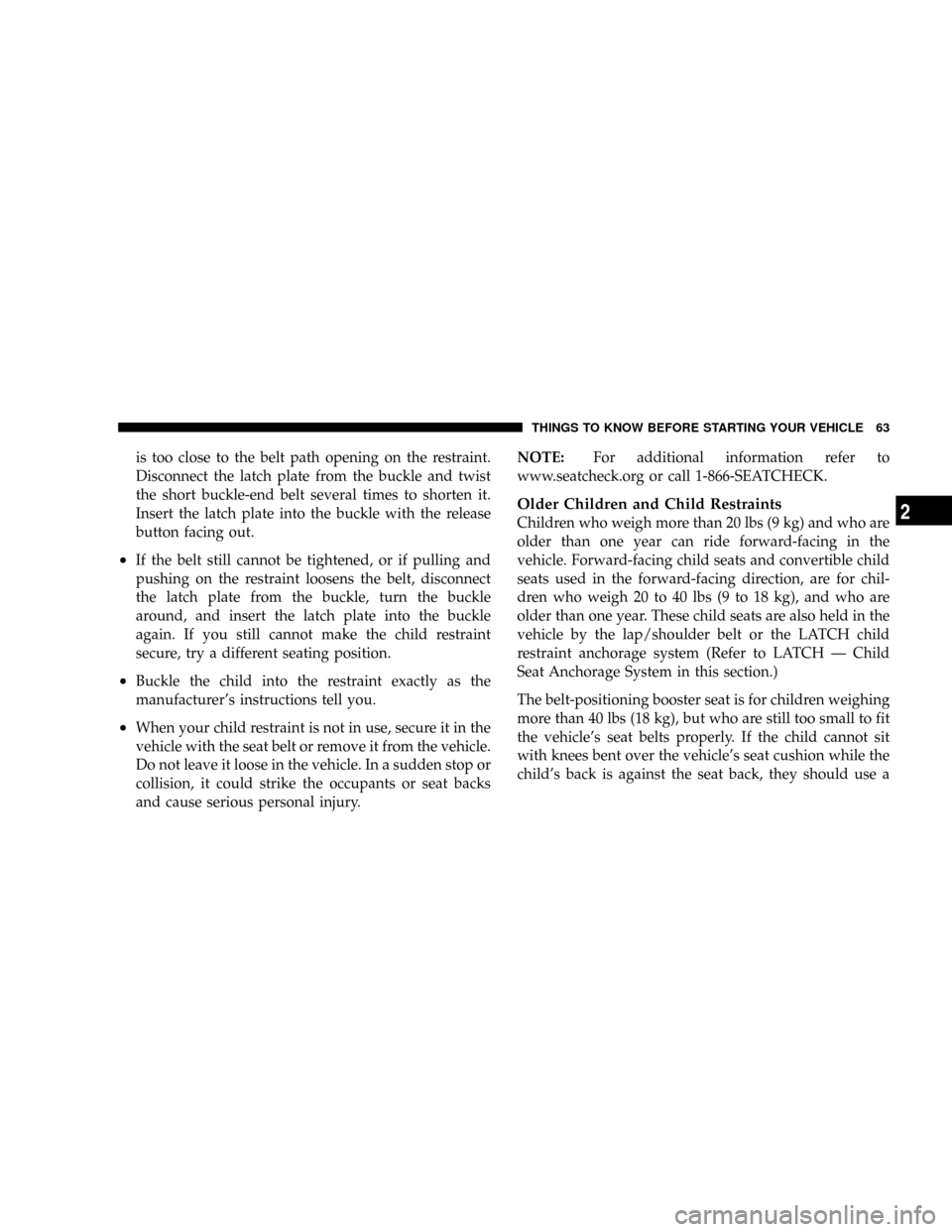
is too close to the belt path opening on the restraint.
Disconnect the latch plate from the buckle and twist
the short buckle-end belt several times to shorten it.
Insert the latch plate into the buckle with the release
button facing out.
²If the belt still cannot be tightened, or if pulling and
pushing on the restraint loosens the belt, disconnect
the latch plate from the buckle, turn the buckle
around, and insert the latch plate into the buckle
again. If you still cannot make the child restraint
secure, try a different seating position.
²Buckle the child into the restraint exactly as the
manufacturer's instructions tell you.
²When your child restraint is not in use, secure it in the
vehicle with the seat belt or remove it from the vehicle.
Do not leave it loose in the vehicle. In a sudden stop or
collision, it could strike the occupants or seat backs
and cause serious personal injury.NOTE:For additional information refer to
www.seatcheck.org or call 1-866-SEATCHECK.
Older Children and Child Restraints
Children who weigh more than 20 lbs (9 kg) and who are
older than one year can ride forward-facing in the
vehicle. Forward-facing child seats and convertible child
seats used in the forward-facing direction, are for chil-
dren who weigh 20 to 40 lbs (9 to 18 kg), and who are
older than one year. These child seats are also held in the
vehicle by the lap/shoulder belt or the LATCH child
restraint anchorage system (Refer to LATCH Ð Child
Seat Anchorage System in this section.)
The belt-positioning booster seat is for children weighing
more than 40 lbs (18 kg), but who are still too small to fit
the vehicle's seat belts properly. If the child cannot sit
with knees bent over the vehicle's seat cushion while the
child's back is against the seat back, they should use a
THINGS TO KNOW BEFORE STARTING YOUR VEHICLE 63
2
Page 64 of 478

belt-positioning booster seat. The child and belt-
positioning booster seat are held in the vehicle by the
lap/shoulder belt.
Children Too Large for Booster Seats
Children who are large enough to wear the shoulder belt
comfortably, and whose legs are long enough to bend
over the front of the seat when their back is against the
seat back, should use the lap/shoulder belt in a rear seat.
²Make sure that the child is upright in the seat.
²The lap portion should be low on the hips and as snug
as possible.
²Check belt fit periodically. A child's squirming or
slouching can move the belt out of position.
²If the shoulder belt contacts the face or neck, move the
child closer to the center of the vehicle. Never allow a
child to put the shoulder belt under an arm or behind
their back.
LATCH Ð Child Seat Anchorage System (Lower
Anchors and Tether for CHildren)
Your vehicle's second row seat is equipped with the child
restraint anchorage system called LATCH. The LATCH
system provides for the installation of the child restraint
without using the vehicle's seat belts, instead securing
the child restraint using lower anchorages and upper
tether straps from the child restraint to the vehicle
structure.
LATCH-compatible child restraint systems are now avail-
able. However, because the lower anchorages are to be
introduced over a period of years, child restraint systems
having attachments for those anchorages will continue to
also have features for installation using the vehicle's seat
belts. Child restraints having tether straps and hooks for
connection to the top tether anchorages have been avail-
able for some time. For some older child restraints, many
child restraint manufacturers offer add-on tether strap
64 THINGS TO KNOW BEFORE STARTING YOUR VEHICLE